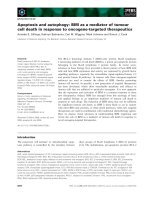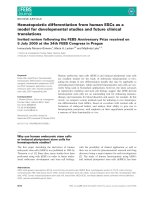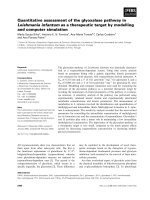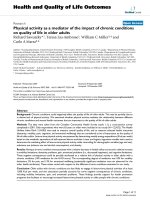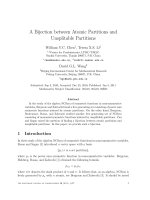Talk it through childrens language skill as a mediator between intrusive parenting and childrens externalizing behavior problems
Bạn đang xem bản rút gọn của tài liệu. Xem và tải ngay bản đầy đủ của tài liệu tại đây (642.23 KB, 132 trang )
i
TALK IT THROUGH:
CHILDREN'S LANGUAGE SKILL AS A MEDIATOR BETWEEN INTRUSIVE
PARENTING AND CHILDREN'S EXTERNALIZING BEHAVIOR PROBLEM
ZHOU YU QI
DEPARTMENT OF PSYCHOLOGY
2013
ii
iii
TALK IT THROUGH:
CHILDREN'S LANGUAGE SKILL AS A MEDIATOR BETWEEN INTRUSIVE
PARENTING AND CHILDREN'S EXTERNALIZING BEHAVIOR PROBLEM
ZHOU YU QI
(B.M., Fudan University, China)
A THESIS SUBMITTED
FOR THE DEGREE OF DOCTOR OF PHILOSOPHY IN PSYCHOLOGY
DEPARTMENT OF PSYCHOLOGY
NATIONAL UNIVERSITY OF SINGAPORE
2013
iv
DECLARATION
I hereby declare that this thesis is my original work and it has been written by me in its entirety.
I have duly acknowledged all the sources of information which have been used in the thesis.
This thesis has also not been submitted for any degree in any university previously.
__________________________
Zhou Yu Qi
20 December 2013
i
Acknowledgement
I would like to thank the following people:
Dr. Ryan Hong, my supervisor and chair of the thesis committee, for his guidance and support during
the last part of my PhD journey, his patience and understanding of my imperfection, his openness for
discussion and exploration. This intellectual adventure would not be possible without his generosity
and leadership of the whole project.
Dr. Tan Seok Hui, for her introduction me to the Infant Lab (the Baby lab), her solid expertise and
advice in the area of child language, her humor and encouragement during tough times.
Professor John Elliott, for the valuable input on my work and many critical questions that push my
work to a higher standard.
Professor Leher Singh, for her generous permission for me to conduct experiments at the Infant
Language Center.
Ilyana, Xin yi, Felicia, Bai hui, and Edlyn, for the collective work we share in the long, dreary coding
process, and the discussion we had about pattern of the data.
Pearl, Si min, Jie ying for the help with my experiment, and for accommodating many of my urgent
requests.
Yi Wei, Elaine, Stephanie, Sze Ying, and the whole project team that I'm proudly a member of.
Calista, Hoi Shan, Shi Min, and Su Qi, for the life we share at grad room and at lab, for the support
you gave me during my low times. Can't imagine how boring the life would be without your gossips.
All parents and children who spent their time and effort participating in the MCYS project and my
experiment.
Cisy, for the love and passion, for the numerous interests and topics we share, for the ability to read
my mind whenever. Your company has always enlightened my life, no matter how hard it is.
My parents, for all the good qualities that I have grown into as an adult, the calmness, intellectual
curiosity, for the sufficient autonomy given to me to pursue my dream, for the unconditional support
and care that I always receive.
ii
Contents
Acknowledgement i
Summary iv
List of Figures and Tables v
List of Abbreviation vi
Introduction 1
Parental intrusiveness as a specific form of control 3
Chapter 1: Study 1 Literature Review 6
History and Definition 6
Intrusive Parenting and Children's Externalizing Behaviors 7
Explaining the Mechanism 10
Children's language skills as a potential mediator. .12
Language skills and externalizing behavior. 13
Parenting behavior and children's language skills.. 15
The Current Study 18
Chapter 2 : Study 1 Method 21
Participants . 21
Procedure 22
Measures and Instruments 22
Chapter 3 : Study 1 Results 35
Missing Value Analysis 35
Descriptive Statistics .35
The Structural Equation Model 42
Test of Indirect Effect 47
Moderation by Gender and SES 48
Chapter 4 : Study 1 Discussion 52
Language as a Mediator .52
Moderation by Gender and SES 55
Strength, Limitation, and Implication for Future Research 56
Chapter 5 : Study 2 Literature Review 60
Parental Interruption and Children's Speech Disfluency 60
iii
Normal Disfluency and Stuttering-Like Disfluency 64
The Current Study 65
Chapter 6 : Study 2 Method 67
Participants . 67
Procedure and Manipulation 67
Measures and Instruments 69
Chapter 7 : Study 2 Results 73
Descriptive Statistics .73
Effects of Interruption .73
Chapter 8 : Study 2 Discussion 79
The Effect of Interruption on Children's Speech Behavior 79
Limitation of the Study 82
Chapter 9 :General Discussion 84
Implication for Future Research 87
Conclusion 88
Reference 90
Appendix A. Intrusive Parental Behavior Coding Scheme 112
Appendix B Instruction for Experimenter in the Block Building Task 116
iv
Summary
Intrusive parenting behavior has long been associated with children's behavioral problems,
but the process through which intrusive parenting exert its effect has not been fully understood. This
dissertation investigated how children's language skills serve as mediators between intrusive
parenting and children's externalizing behavior problem. In Study 1, 264 children and their parents
were assessed for parental behavior, children's behavioral adjustments and children's language skills.
Structural Equation Modeling showed that children's language skills mediated the effect of intrusive
parenting on children's adjustment problems. In Study 2, 22 children of age similar to those in Study 1
were randomly assigned to interact with either an interruptive or a neutral experimenter. Children who
interacted with an interruptive experimenter produced more speech errors in their later story-telling
activity. These results showed that the association between intrusive parenting and children's
behavioral problems can be explained by variation in children's language skills. Implication for
understanding the role language plays in children's socio-emotional adjustment is discussed.
v
List of Figures and Tables
Figure 1. The hypothesized mediational model 20
Table 1. Correlations Among Different Types of Intrusive Parenting Behavior 28
Figure 2. Mean and standard error of four different types of intrusive behavior 28
Figure 3. Distribution of the intrusive scores of parents in the study 29
Table 2. Means and Standard Deviations for Study Measures 37
Table 3. Zero-Order Correlations for Study Measures for Original Sample and EM completed
Sample 38
Table 4. Correlations Among Study Measures by Gender 41
Figure 4. Model fit and unstandardized parameter estimate for the initial model 43
Figure 5. Model fit and unstandardized parameter estimate for the hypothesized meditational
model 46
Table 5. Means and Standard Deviations for Demographic & Language Background
Measures 74
Table 6. Means and Standard Deviations of Study Measures 74
Figure 6. The interaction effect between measurement time point and experiment condition on
children's speech length 75
Figure 7. The interaction effect between measurement time point and experiment condition on
children's speech disfluency 75
Figure 8. The interaction effect between measurement time point and experiment condition on
children's type-token ratio 76
Figure 9. The effect of interruptive behavior on children's self-reported moods 78
Figure 10. A typical flow of an epoch during interaction 122
vi
List of Abbreviation
ANOVA Analysis of Variance
BLAB Bilingual Language Assessment Battery
CBCL Child behavior check list
CHILDES Child Language Data Exchange System
CPM Coloured Progressive Matrices
DC Demands and Capacity
EM Expectation Maximization
ND Normal Disfluency
SLD Stuttering-Like Disfluency
SEM Structural Equation Modeling
SES Social Economic Status
TTR Type-Token Ratio
1
Introduction
Children’s problem behaviors, or behaviors that are undesirable and maladaptive in
children’s development, have long been a major concern among developmental researchers.
In particular, externalizing behavior problems refer to a domain of problematic behaviors
such as aggression or being defiant of other people’s expectations or requests (Achenbach &
Edelbrock, 1981; Achenbach & Rescorla, 2001). Children with externalizing behavior
problems may purposefully disobey their parents’ orders, inflict physical harm on peers or
siblings, or engage in behaviors that are undesirable for the child, such as telling lies, and
destroying public properties. These behaviors could be observed from normally developing
children from time to time, but extreme presence of these behaviors are often regarded as
indicators of psychopathology that may require clinical intervention (Achenbach & Rescorla,
2001).
Parents play an important role in the developmental trajectory of children's
externalizing behaviors. For example, parents can exert positive influence on children and
ameliorate their tendency to “acting out” by being warm and accepting (Paterson & Sanson,
1999). Parents can also reduce children's externalizing behaviors by employing proactive
parenting, a constellation of behaviors that support children’s autonomy while at the same
time set clear instructions and limits for children’s behaviors (Denham et al., 2000). In
contrast, parents’ anger and hostility often have devastating effects on children’s adjustment.
Children who frequently experience these negative emotions from parents tend to be highly
aggressive and disruptive, and are more likely to maintain in this style of interaction when
2
they grow up (Buehler, Lange, & Franck, 2007; Denham et al., 2000; Ge et al., 1996). When
disciplining their children, parents who employ a set of coercive, controlling strategies (e.g.
physical punishment, highly restrictive, threatening, yelling), though temporarily reducing
children’s externalizing behaviors at that moment, are often unlikely to be effective in
preventing their children from behaving in a disruptive manner in the longer term (Colder,
Lochman, & Wells, 1997; Eisenberg et al., 1999). Indeed, these parenting practices are more
likely to reinforce children’s aggressive and defiant behaviors because parents who lose
confidence in regulating children’s behavior may carry out their parenting practices
inconsistently (Patterson, 1982).
The effect of parents’ controlling behavior on children’s psychosocial development is
shown to be complicated. Whether these controlling behaviors facilitate or impair children’s
adjustment depends on how the controlling behaviors are conceptualized as well as various
context-specific details. Based on previous empirical research, Barber (1996) has proposed a
distinction between parental “behavioral control” and “psychological control”, stating that
the two forms of parenting strategies have different influences on children’s behavioral
outcomes. According to this proposition, behavioral controlling parents set clear goals for
children to achieve while maintaining supportive for children’s autonomy. This behavior is
beneficial for children's internalization of parental expectations. In contrast, psychological
controlling parents make children feel ashamed or guilty for their misbehavior, often by
reprimanding or even threatening their children, while provide little guidance for appropriate
behavior. Children of these parents will have more difficulties complying with socially
acceptable norms. The anxiety and frustration the child experienced during parent-child
3
interaction may even become another source of behavior dysregulation, increasing their
disruptive behaviors (Barber, 1996). Subsequent empirical investigation has generally
confirmed this distinction of parental "behavioral control" and "psychological control"
(Denham et al., 2000; Eisenberg et al., 1999; Steinberg, Lamborn, Dornbusch, & Darling,
1992).
Parental intrusiveness as a specific form of control
Intrusive parenting, often defined as providing children with excessive help and
instructions which are not necessary, or interfering physically with children’s ongoing
activities, could be regarded as a specific form of parental psychological control (Egeland,
Pianta, & O'Brien, 1993; Rubin, Burgess, & Hastings, 2002; Whiteside-Mansell, Bradley,
Tresch Owen, Randolph, & Cauce, 2003). Although intrusive parents may not use aversive
emotional labels to undermine children’s sense of self efficacy, they may still fail to support
children’s autonomy. This probably stems from a failure to recognize the child as a
psychologically independent individual who should be encouraged to make their own
decisions. Intrusive parents tend to impose their own agenda on their children’s activities,
requiring the latter to follow exactly their expectations, and leaving children little room to
explore their own potentials. Therefore, children with intrusive parents are very likely to be
limited in various domains of cognitive and emotional development. For instance, children of
intrusive parents have been found to have lower scores on cognitive skill tests (Poehlmann et
al., 2012), and to have poorer school readiness (Dotterer, Iruka & Pungello, 2012) than
4
children of non-intrusive parents. In the domain of social interaction, children of intrusive
parents are more likely to show reticent or withdraw behavior (Nelson et al., 2006; Rubin et
al., 2002), to be victimized by peers (Ladd & Ladd, 1998) or to affiliate with deviant peers
during adolescence (Soenens et al., 2007).
Intrusive parenting has also been identified as a predictor of children's externalizing
behaviors. Empirical investigation consistently reported that if parents often interrupt or even
take over children's activities during interaction, their children are more likely to exhibit
aggressive and disruptive behaviors (Barber, 1996; Bradley & Corwyn, 2007; Bradley &
Corwyn, 2008; Carlson, Jacobvitz, & Sroufe, 1995; Egeland et al., 1993; Heller, Baker,
Henker, & Hinshaw, 1996; Miner & Clarke-Stewart, 2008; Mize & Pettit, 1997; Morrell &
Murray, 2003; Pettit, Laird, Dodge, Bates, & Criss, 2001; Whiteside-Mansell et al., 2003).
Studies have also shown this association to be consistent across different cultures (e.g. Chen,
Wu, Chen, Wang, & Cen, 2001; Whiteside-Mansell et al., 2003).
To explain the association between parental influence and children's externalizing
behavior, researchers have proposed many characteristics of children which may serve as
mediators of the process. Previous studies have examined constructs such as children's
emotional understanding, effortful control, and empathy (Belsky et al., 2007; Eiden,
& Leonard, 2007; Eisenberg, Gershoff, et al., 2001; Eisenberg et al., 2000). However, few
studies have treated children's language skills as a potential mediator in this process.
Language is one of the major tools children used to interact with adults and peers. It is also
very important when children have to resolve conflicts during peer interaction and to express
their emotions and needs (Anan & Barnett, 1999). Deficiencies in language skills have been
5
found to be associated with children's behavior problems (Mize & Pettit, 1997). Intrusive or
directive parents have also been shown to interfere with children's language development
(Akhtar, Dunham, & Dunham, 1991). It would be interesting to see whether children's
language capacities could be a mediator between parental intrusiveness and children's
externalizing behavior. So far, no research has been conducted on this mediation hypothesis.
Therefore, the aim of the current thesis is set out to test whether children's language
skills mediate the influence of intrusive parenting on children's externalizing behaviors. Two
studies are included in this thesis: The first is a two-year prospective study capturing the
relationship between intrusive parenting and behavior problems in a correlational design. It
will test whether the mediating paths of children's language skills are significant in a
structural model. The second study is proposed based on the results from the first study. It
intends to provide more information on the nature as well as causal direction between
intrusive parenting, children's language skills, and their problematic behaviors.
6
Chapter 1: Study 1 Literature Review
History and Definition
The earliest documentation of parental intrusive behavior can be traced back to
Mary Ainsworth in her work of child-parent attachment. She noted that certain types of
parental behavior break into or interrupt the baby's ongoing activities. Parents who were
described as "intrusive" often physically interfered with their baby's play, providing
information and activities that were at odds with their children's current attention. Some may
even restrain their babies' activity and forced them to follow their parents' demands
(Ainsworth, Blehar, Waters, & Wall., 1978). Intrusive parents actively provide instructions
and directions to their children, but these instructions are often without regard for their
children's interests and wishes.
In a separate line of research, Barber (1996) proposed a distinction between
parental controlling behaviors that focus on management of children's behaviors, which he
referred to as behavioral control, and controlling behaviors that attempt to intrude into
children's emotional as well as psychological development, which he referred to as
psychological control. Intrusive parenting, according to him, falls into the category of
psychological control, for its lack of regard of children's psychological autonomy and its
excessive and often unnecessary control and possessiveness (Barber, 1996). This
conceptualization was followed and specifically applied to the study of adolescents' social
emotional well-being (Barber, 1996; Soenens et al., 2007).
Recent researchers have adopted a more direct approach in the study of intrusive
7
parental behavior. Intrusive parental behavior is considered as a distinct construct and relate
directly to children's psychological development. Intrusive parental behavior is defined as
interventions that are disruptive of children's ongoing activity. Parents provide instructions or
help when their children do not necessarily need them, and these instructions are often
initiated based on parents' will rather than adapted to children's mood and interests (Carlson,
Jacobvitz & Sroufe, 1995; Murray et al., 1996; Pomerantz & Eaton, 2001). These behaviors
can range from verbal instructions, help, to direct behavioral take-over of the child's activity.
This intrusive parenting construct, though sometimes measured by questionnaire, is more
often captured by behavior observation of child-parent interactions. For example, in a study
by Ladd and his colleagues, behavior coding of maternal intrusiveness during a 5-minutes
child-parent narrative co-construction when the child was about 9 months was related to peer
victimization later at 36 months (Ladd & Ladd, 1998). In another study, maternal
responsiveness-intrusiveness observed during parent-child interaction was associated with
children's cognitive development at 15 months after controlling for socio-economic status
and stressful life events (McFadden & Tamis-Lemonda, 2013).
Intrusive Parenting and Children's Externalizing Behaviors
Among the many developmental outcomes studied for intrusive parenting, the
association between intrusive parenting and children's externalizing behavior is well-
established. During early childhood, parental intrusiveness has been associated with
children's externalizing tendency, either reported by teachers or parents (Mize & Pettit, 1997;
8
Whiteside-Mansell et al, 2003). In the study by Whiteside-Mansell and her colleagues,
parents and their children were instructed to play in a laboratory setting when their children
were 36 months old. The interaction was video-taped through a one-way mirror. Before the
interaction, mothers were instructed to have their children play with materials contained in
three different boxes in a given order. Parental intrusiveness was coded based on whether the
parent "recognizes and accords validity to the child's individuality, motives, and
perspectives" (pp. 205, Whiteside-Mansell et al, 2003). Those parents also completed Child
Behavior Checklist (CBCL), which was designed to measure children's problematic
behaviors. Results showed that parent's intrusive behavior was positively associated with
children's aggressive subscale as well as destructive subscale from the CBCL.
The association between intrusive parenting and children's externalizing behavior
has also been observed for children during middle childhood. In the study by Egeland and
colleagues (1993), mothers were instructed to play with their children at home. The play
session was a combination of no toy play, play with a standard set of toys provided by the
experimenter, and free play. Mother's intrusive tendency was rated based on Mary
Ainsworth's Scale of Cooperation and Interference (Ainsworth et al., 1978). Children's
primary school teacher independently completed CBCL based on their experiences with these
children at school. Those researchers found that children of more intrusive mothers have
significantly higher score of aggressive and externalizing behaviors than children of non-
intrusive mothers (Egeland , Pianta, & O'Brien. 1993). This association was confirmed by
other researchers as well (Bradley & Corwyn, 2007; 2008). Furthermore, researchers found
that children's temperament seems to be a moderator for this association. In particular, the
9
association between intrusive parenting and children's externalizing behavior was found to be
stronger for children with difficult temperament (Bradley & Corwyn, 2008; Miner & Clarke-
Stewart, 2008).
In addition to concurrent findings, longitudinal investigations also support the
relationship between intrusive parenting and children's behavior problems. Maternal
intrusiveness observed before the child's first birthday was found to be predictive of the
child's externalizing problems when they were five and six years old (Bates et al., 1991).
Mothers' intrusiveness observed when their children were at around 1 year old was also be
predictive of their children's conduct problem at 8 years old (Morrell & Murray, 2003). Other
than the aggressive aspect of externalizing problem, evidence also exist for link with
children's attention problems. Empirical evidence suggested that maternal intrusiveness
observed at 6 months were predictive of children's hyperactivity and distractibility both in
early and middle childhood, after controlling for other environmental and genetic factors
(Carlson, Jacobvitz & Sroufe, 1995).
To provide some preliminary evidence of the causal direction between intrusive
parenting and children’s disruptive behaviors, researchers implemented intervention studies
aimed at alternation of parents' behavior. They found that for adult with insecure Adult
Attachment Interview classification, their children were significantly less likely to exhibit
externalizing problems if those parents were provided with instructions and video-feedback
on parental sensitivity and skills to support children's autonomy. (Velderman et al., 2006).
Evidence for the cultural universality for the negative influence of intrusive parenting
has also been found. Parental intrusiveness has been found to be associated with children’s
10
externalizing problem behaviors for African Americans as well as for children from mainland
China (Chen, Wu, Chen, Wang, & Cen, 2001; Whiteside-Mansell et al., 2003).
Explaining the Mechanism
As research has generally confirmed the link between intrusive parenting and
children’s externalizing behaviors, increasing attention has been directed at exploring the
mechanisms through which those parenting behaviors affect children’s developmental
outcomes (Belsky et al., 2007). In other words, researchers have been looking for the
mediators between parental behaviors and children's externalizing behaviors. Though
parental intrusive behavior has not exactly been the topic of investigation, many mediating
factors have been proposed and tested for some other yet relevant parental behaviors and
their developmental outcomes. For instance, children’s command of situational emotion
knowledge has been found to account for the relationship between parental warmth and
children’s subsequent externalizing behavior problems (Zhou et al., 2002). Parental warmth
and other positive emotional expressions foster children’s understanding of other people’s
emotion states under various settings, which in turn decreases their tendency to show
aggressive behaviors that may take effect of eliciting negative emotion from others (Garner,
Dunsmore, & Southam-Gerrow, 2008; Zhou et al., 2002).
Besides, children’s ability to regulate their attention, or to appropriately maintain
focus, direct attention to other objects when needed, has also been regarded as an important
factor in explaining the individual difference in externalizing problem behaviors. Parental
11
provision of positive as well as negative emotion has been found to modulate children's
attention regulation. Children with better attention regulation skills are more likely to be
rated low on various types of externalizing behaviors. (Belsky et al., 2007; Eiden, Edwards,
& Leonard, 2007; Eisenberg, Gershoff, et al., 2001; Eisenberg et al., 2000). This finding has
also been replicated with a group of children in Indonesia, with a slight difference that only
parents’ negative emotions, but not positive ones, were mediated by children’s attention
regulation, influencing their externalizing behaviors (Eisenberg, Liew, & Pidada, 2001).
It is possible that different parental behaviors are influencing children’s
developmental outcome through different mediating variables. And it is also important to
point out that, so far most studies on the mediating psychological process have focused on
factors intrinsic to children themselves. They emphasize children’s ability to interpret and
understand social situations, as well as to regulate their behaviors according to social
expectations. These factors reflect the “static side” of social interaction, in that children are
regarded as a passive recipient of environment information, and the success of behavior
regulation is attributed to the process occurred within children themselves. However, a child
is not only a recipient and processor of social information, but also an active participant of
social interaction by generating their response and initiate new behaviors. Therefore,
children’s social world should not be regarded as solely consisting of understanding the
external world. It also involves extensive interactions between the child and different parties
such as peers and teachers. They actively engage themselves in these interactions by
expressing feelings, exchanging thoughts and resolving conflicts. Investigation of these
dynamic factors could shed new lights on the process through which children adapt
12
themselves to social expectations, and provide a more integrated picture of their adjustment
and problem behaviors.
Children's language skills as a potential mediator.
Language is a very important tool children use to interact with the external world
as well as to express their emotions and needs to others. Deficiencies in language skills are
likely to impair children's social functioning, which will in turn influence their socio-
emotional adjustment. Children's language skills can be related to their adjustment for several
reasons. First, language serves as an important tool for children when they need to resolve
conflict and express their emotion to others. Researchers have long acknowledged that verbal
communication is the most likely method children will choose to express themselves under
distress (Shipman et al., 2003). Observation of children's friendship and peer interaction
often reveals the fact that children's peer interaction in kindergarten and school-age is highly
language-based, and better quality peer interaction is often marked by more flexible usage of
language to verbalize about the interaction topic (Bonino & Cattelino, 1999; Pellegrini,
Galda, & Flor, 1997). In this sense, better language ability enables children to play a more
active role in their social interaction, and allow them to be more resourceful when
negotiation and communication is necessary. Secondly, development in language skills is
likely to facilitate children's self-regulation and attention control, thus decreasing their
likelihood to act impulsively. Researchers have proposed that language may facilitate
children's self-regulation through the form of "self-directed speech", which can help children
13
keep focus on the current object and facilitate problem solving (Peterson et al., 2013).
Children use speech as a tool to monitor and modify their emotions and behaviors
accordingly. Intervention focused on children's use of self directed speech was found to
improve young children's cognitive performance as well as their behavioral regulation
(Barnett, et al., 2008). Individual differences in language development have also been found
to be predictive of children self-regulation (Vallotton & Ayoub, 2011). Thirdly, children with
better language skills are more likely to be accepted and become popular in their social
environment, either with their peers or with adults. This difference in popularity is likely to
influence their adjustment. Studies have shown that children who lag behind their peers in
language and communication development have lower peer status in their groups, and were
often the target of peer victimization in kindergarten and school (Grunigen et al. 2010; Laws
et al, 2012). Their language competence is closely related with their reported peer
Furthermore, children also seem to be aware of the peer status themselves, and this
perception of self competence has been found to be correlated with objective measurement of
their language competence (Jambunathan & Norris, 2000). Thus the difference in language
competence also underlies the difference in children's peer status, both of which could
become components in their self identity and affect their social adjustment.
Language skills and externalizing behavior.
Empirical evidence supporting the relationship between language abilities and
children's externalizing problem is abundant. School-age children with dyslexia or other type
14
of speech language impairment (SLI) are often found to have elevated scores on scales of
externalizing problems (Benasich, Curtiss, & Tallal, 1993; Heiervang et al., 2001;
Noterdaeme & Amorosa, 1999). Measures of their behavior problems were also correlated
with their language competence within this population (van Daal, Verhoeven, & van Balkom,
2007). A meta-analysis of 19 prospective studies showed that between 3 to 12 years old, SLI
children were about two times more likely to show high levels of overall internalizing,
overall externalizing, and attention problems than typically developing children (Yew &
O'Kearney, 2013). Though differed from typically developing children in many other aspects,
children with SLI are likely to find social interaction a more challenging task because of the
difficulties in language understanding and productions. Extra effort and frustration
experienced during communications would make it more difficult to resolve conflicts and
express desire, which may in turn affect their socio-emotional adjustment at the general level.
For typically developing children, the association between language skills and
behavior problems is also prevalent. Standard measures of children's receptive vocabulary
and verbal skills were associated with children's externalizing behaviors both reported by
teacher (Mize & Pettit, 1997) and their parents (Dietz et al., 1997). Low overall scores of
language comprehension and production skills were predictive of children's later
externalizing problems at 12 years old, controlling for initial levels of behavior problems.
(Beitchman et al., 1996). Language difficulties were also found associated with children's
school exclusion during middle childhood (Clegg et al., 2009). In a most recent study
conducted by Peterson and his colleagues, a cross-lagged longitudinal model was employed
to test whether children's language skills independently predicted their subsequent behavior
15
problem in a nationally representative sample in United States. Results showed that
languages skills measured during early childhood significantly predicted children's
externalizing behavior problems at 13 years old, after controlling for families' socio-
economic status, and other cognitive skills such as math ability and working memory
(Peterson et al., 2013). Furthermore, children's language knowledge has already been found
to mediate the relationship between children's social cognition and their externalizing
behavior (Zadeh, Im-Bolter & Cohen, 2007). In summary, children's language skills has been
found to be consistently related to their behavior problems. It has also been found to mediate
the effect of other constructs which were thought to be underling children's externalizing
behavior. Therefore, it will be very interesting to see if language skill is an important
mediator between parental behavior and children's externalizing behavior as well.
Parenting behavior and children's language skills.
Parents play a key role in children's language development. They are the
individuals whom children interact with most during the early years, and provide the
environment in which children learn and practice their language skills. On one hand, parents
serve as natural template and the main source of information for children's language
acquisition. Parents' ability to provide linguistically stimulating environment is influencing
children's language development. Research has shown that the amount of explanation parents
use to describe object labels was associated with children's vocabulary size (Callanan &
Sabbagh, 2004); parents' usage of sophisticated words also predicted children's vocabulary


